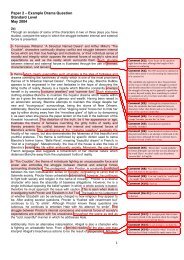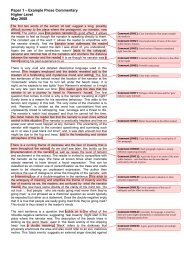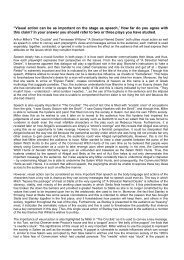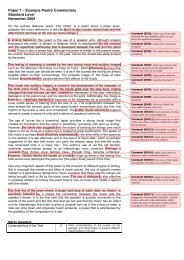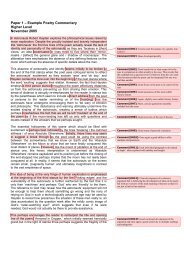Truth & Reconciliation in Death and the Maiden - Mr Hoye's IB ...
Truth & Reconciliation in Death and the Maiden - Mr Hoye's IB ...
Truth & Reconciliation in Death and the Maiden - Mr Hoye's IB ...
- No tags were found...
You also want an ePaper? Increase the reach of your titles
YUMPU automatically turns print PDFs into web optimized ePapers that Google loves.
which has no power to punish those who carried our crimes under <strong>the</strong> regime, <strong>and</strong> canonly address cases <strong>in</strong> which <strong>the</strong> victims died, suggests that she desires a more severeform of retribution aga<strong>in</strong>st her abductors; an op<strong>in</strong>ion no doubt shared by many of thosewho suffered under <strong>the</strong> regime. As she comments to Gerardo, “You hear <strong>the</strong> relativesof <strong>the</strong> victims, you denounce <strong>the</strong> crimes, what happens to <strong>the</strong> crim<strong>in</strong>als?”However, it is only when she imprisons Roberto <strong>and</strong> is suddenly given <strong>the</strong> opportunityto exact justice as she seen fit, that she f<strong>in</strong>ds herself faced with some truly difficultdecisions associated with justice <strong>and</strong> reconciliation. Do Roberto’s crimes, assum<strong>in</strong>gthat he is guilty, warrant <strong>the</strong> penalty of death? Or should Paul<strong>in</strong>e sacrifice revenge <strong>and</strong>personal closure for <strong>the</strong> sake of a safer, more unified future? As Roberto says whenplead<strong>in</strong>g for his life:“So someone did terrible th<strong>in</strong>gs to you <strong>and</strong> now you’re do<strong>in</strong>g someth<strong>in</strong>g terrible tome <strong>and</strong> tomorrow someone else is go<strong>in</strong>g to – on <strong>and</strong> on <strong>and</strong> on. I have children,two boys, a girl. Are <strong>the</strong>y supposed to spend <strong>the</strong> neat fifteen years look<strong>in</strong>g foryou until <strong>the</strong>y f<strong>in</strong>d you?”’Although this sentiment has its merits, one cannot help but sympathise with Paul<strong>in</strong>a’spredicament. As <strong>the</strong> gruesome details of her abduction gradually emerge, <strong>the</strong> audiencefeels compassion for her <strong>and</strong> anger on her behalf. Dorfman’s use of coarse, disturb<strong>in</strong>glanguage <strong>in</strong> describ<strong>in</strong>g her <strong>in</strong>carceration pa<strong>in</strong>ts a graphic picture <strong>and</strong> effectivelyconveys <strong>the</strong> horror of <strong>the</strong> experience. As such, it seems unfair that, after suffer<strong>in</strong>g somuch, Paul<strong>in</strong>a should have to sacrifice her only chance of exact<strong>in</strong>g justice as she seesfit. In evok<strong>in</strong>g such sympathy for her, Dorfman is show<strong>in</strong>g <strong>the</strong> flaws <strong>in</strong> <strong>the</strong> commission’splans for leav<strong>in</strong>g <strong>the</strong> crim<strong>in</strong>al unpunished.Gerardo’s attitude towards <strong>the</strong> conflict between his wife <strong>and</strong> Roberto reflects <strong>the</strong> viewsof <strong>the</strong> commission. Not hav<strong>in</strong>g been directly victimised by <strong>the</strong> regime, he cannot trulyunderst<strong>and</strong> <strong>the</strong> extent of Paul<strong>in</strong>a’s suffer<strong>in</strong>g say<strong>in</strong>g to her, “How can you possibly bethis way, talk this way,” <strong>and</strong>, “What are you try<strong>in</strong>g to do, woman, with <strong>the</strong>se <strong>in</strong>saneacts?” This apparent lack of empathy <strong>and</strong> sense of detachment perhaps provides <strong>the</strong>foundations for his belief that, if <strong>the</strong> crimes perpetrated under <strong>the</strong> regime can beexplored <strong>and</strong> established objectively, his country will be able to “close an exceptionallypa<strong>in</strong>ful chapter - <strong>in</strong> our history” without <strong>the</strong> need for fur<strong>the</strong>r violence. However, thanksto our sympathy for Paul<strong>in</strong>a <strong>and</strong> thus, <strong>in</strong>directly, for <strong>the</strong> victims of <strong>the</strong> regime, <strong>the</strong>audience recognises <strong>the</strong> flaws <strong>in</strong> this idea of justice. Difficult questions are raised; forexample, if <strong>the</strong> crimes are buried end <strong>the</strong> perpetrators left unpunished, what is toprevent future repetition of past atrocities? Never<strong>the</strong>less, Gerardo is conv<strong>in</strong>ced thatreconciliation is <strong>the</strong> only way forward for his country <strong>and</strong>, on a more personal level, hiswife. His views thus reflect those of <strong>the</strong> citizens of an emerg<strong>in</strong>g democracy who believethat it is worth forgiv<strong>in</strong>g past crimes for <strong>the</strong> sake of future democratic stability <strong>and</strong> unity.Instead of giv<strong>in</strong>g a def<strong>in</strong>ite resolution to <strong>the</strong> dramatic conflict between <strong>the</strong>se threecharacters, Dorfman leaves unanswered <strong>the</strong> question of Roberto’s fate at <strong>the</strong> h<strong>and</strong>s ofPaul<strong>in</strong>a. This is <strong>in</strong>dicative of his belief that it is <strong>the</strong> issues explored dur<strong>in</strong>g <strong>the</strong> conflictitself that are important, not <strong>the</strong> outcome. It also suggests that he is not offer<strong>in</strong>g anyprescriptive answers to <strong>the</strong> questions he raises, <strong>and</strong>, <strong>in</strong> a political context, is <strong>in</strong> no waytak<strong>in</strong>g it upon himself to dictate how an emerg<strong>in</strong>g democracy can solve its problems.Towards <strong>the</strong> end of <strong>the</strong> play, he uses <strong>the</strong> dramatic device of “a giant mirror whichdescends, forc<strong>in</strong>g <strong>the</strong> members of <strong>the</strong> audience to look at <strong>the</strong>mselves”’ to <strong>in</strong>vite <strong>the</strong>audience to consider what <strong>the</strong>y would do <strong>in</strong> situations such as those faced by hischaracters, <strong>and</strong> to convey that <strong>the</strong> issues explored <strong>in</strong> his play can be applied on apersonal level by every memberIn his powerful <strong>and</strong> evocative play <strong>Death</strong> <strong>and</strong> <strong>the</strong> <strong>Maiden</strong>, Ariel Dorfman explores someof <strong>the</strong> issues associated with justice end reconciliation on both a personal <strong>and</strong> politicallevel His characters face difficult decisions regard<strong>in</strong>g guilt, sacrifice, forgiveness,punishment <strong>and</strong> peace, all of which have political significance for a new democracy. Indepict<strong>in</strong>g both Paul<strong>in</strong>a’s suffer<strong>in</strong>g <strong>and</strong> Gerardo’s desire for future stability, Dorfman issuggest<strong>in</strong>g that <strong>the</strong>re are no easy answers to such questions, <strong>and</strong> leaves it up to hisaudience to reflect upon <strong>the</strong> issues raised.Comment [KH14]: Detailedanalytical comments started with a keyverb like ‘suggests’ – if you are notus<strong>in</strong>g verbs like this <strong>in</strong> your essay <strong>the</strong>nyou are not do<strong>in</strong>g much analysisComment [KH15]: A clear <strong>in</strong>sight<strong>in</strong>to <strong>the</strong> more <strong>in</strong>terest<strong>in</strong>g issues raisedby <strong>the</strong> textComment [KH16]: Although it isgenerally better to smoothly <strong>in</strong>cludequotations. When you quote largesections of texts, it is correct to set<strong>the</strong>m out <strong>in</strong> this wayComment [KH17]: Clear awarenessof <strong>the</strong> effect on <strong>the</strong> audience.Comment [KH18]: Clear analysiswith reference to <strong>the</strong> effect on <strong>the</strong>audience. Note that <strong>the</strong> use of literaryterms is unpretentious <strong>and</strong> focused.Simple terms like ‘coarse language’ <strong>and</strong>‘graphic picture’ are used successfully<strong>and</strong> conv<strong>in</strong>c<strong>in</strong>gly here.Comment [KH19]: Clear confidentanalysis of <strong>the</strong> effect created by <strong>the</strong>authorComment [KH20]: Good, smoothuse of quotationsComment [KH21]: Aga<strong>in</strong> good cleargrasp of <strong>the</strong> audience’s response to <strong>the</strong>playComment [KH22]: Clear clos<strong>in</strong>gsentences that reflect <strong>the</strong> po<strong>in</strong>t made<strong>in</strong> this paragraphComment [KH23]: The c<strong>and</strong>idatemoves towards <strong>the</strong> conclusion byexplor<strong>in</strong>g <strong>the</strong> subtle literary feature‘<strong>the</strong> fact that <strong>the</strong> questions are leftunanswered’ – although <strong>the</strong>re is nosimple technical term for this it is aliterary feature as real <strong>and</strong> considerablymore powerful than assonance oralliteration.Comment [KH24]: Clearunderst<strong>and</strong><strong>in</strong>g of one of <strong>the</strong> potentialmessages of <strong>the</strong> playwrightComment [KH25]: The c<strong>and</strong>idaterema<strong>in</strong>s aware that this is a play, withdramatic effects, <strong>and</strong> not just a novelComment [KH26]: Clear concisesummary of <strong>the</strong> overall <strong>the</strong>sis of <strong>the</strong>essay.






